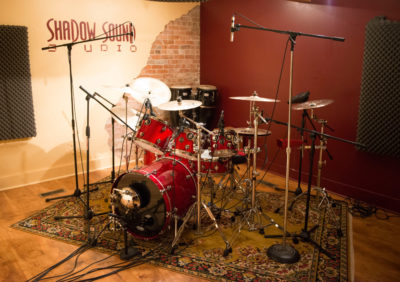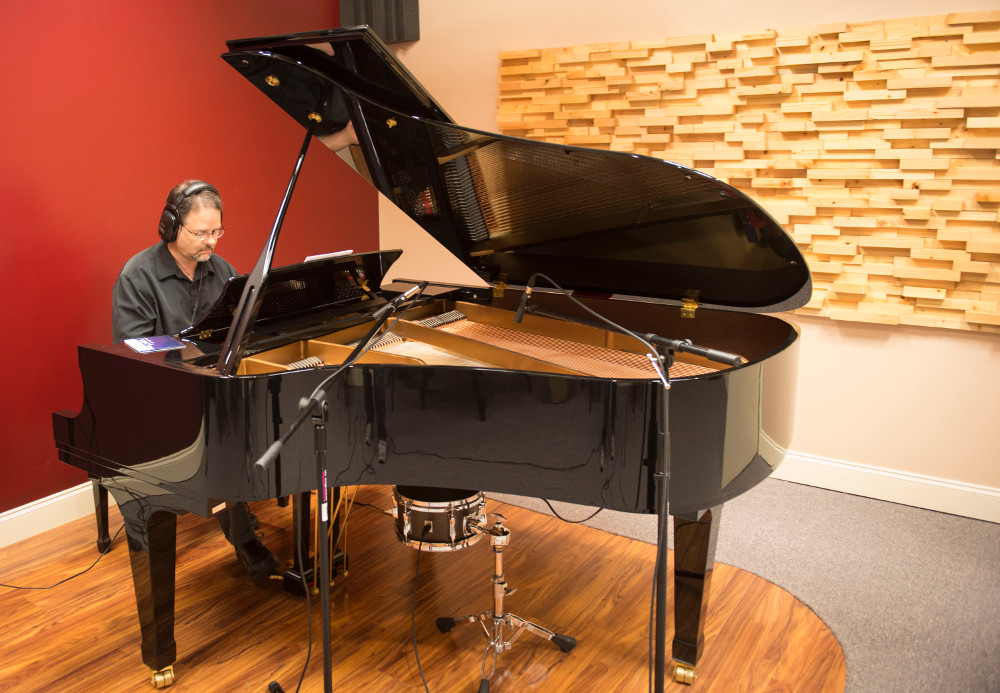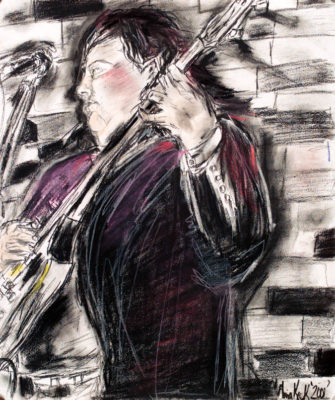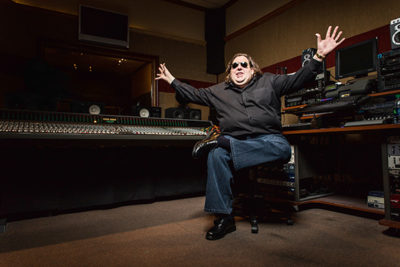Flying Blind: The Unusual Story of Shadow Sound Studio
There’s not so much about the city of Macon that suggests a superhero resides there. Until you look at the map.
Bullseye in the center, there Macon is: the Heart of Georgia. Maybe living here is how an audio engineer named Joey Stuckey achieved such perfect balance — or maybe it comes from somewhere even deeper.
You’d have to dig deep to do what Stuckey does, which is operate a busy commercial recording studio despite being totally blind. With no visual input, Stuckey successfully steers Shadow Sound Studio’s tracking and mixing operations, servicing a steady stream of clients from rock to hip hop to gospel.
Stuckey’s ability to accomplish that stems from that aforementioned balance: It’s an inner peace and nonstop energy, powered by a love for sound that’s superhuman, if not downright superheroic. “I spend about 12 hours a day at the studio, and what do I do when I get home? I listen to music,” says Stuckey. “I’m obsessed with music, and I think in a healthy way. I tell my students, ‘If you don’t hurt when you’re not doing music, then this isn’t for you. Every day making music is a triumph.’”
For Stuckey, who also lost his sense of smell along with functioning thyroid and adrenal glands due to a nonmalignant brain tumor at age 18 months, life has always been about facing challenges head on. “My philosophy is that however I can grow from a situation, I’m interested,” he says. “I do a lot of inspirational speaking, talking to people about what living a successful life means, and how I’ve done that as a brain tumor survivor and a blind person.
“Once you’ve defined what success is for you, it’s very easily within reach. If you want airplanes and limousines, be honest about that. For me, success is sharing my story through music, reminding people of an idea or connecting them to some source of inspiration. If I can do that, and put food on the table, I’ll be successful.”
Not Your Typical Workflow
In a field where careers and reputations are built on the capabilities of one’s ears, audio professionals also depend heavily on their eyes to do their jobs. Just try miking a drum set, adjusting compressor settings — or how about running a Pro Tools session — with your eyelids slammed shut, and you’ll be reminded of the major role optics play in audio production.
“There are things that are annoying about being blind in the audio industry, especially with the design of computer technology,” Stuckey concedes. “But with analog equipment, the knob on the left side of the unit does the same thing every time. I think the fact that I’m drawn to analog happens to be very fortunate, because over the years I’ve realized that analog gear gives the artist and me the character that we’re looking for.
“I don’t believe in sticking music in a box and saying, ‘If you don’t sound like ‘X’, you can’t be a pop artist,’” continues Stuckey, who himself is a classically trained guitarist with six studio albums under his belt. “We’ve already got a Kelly Clarkson — we don’t need another one. I don’t think everyone can fill stadiums, but everyone can have a valid career that inspires people. I want to get the artist to sound as much like themselves as possible.”
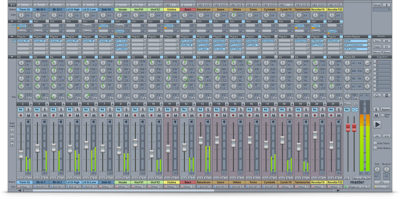
Stuckey can work with MAGIX Samplitude via a convergence of screen readers, custom scripts and macros.
Although analog plays heavily into the sonics at Shadow Sound, Stuckey does use a DAW. Currently, he employs MAGIX Samplitude, although the hunt for a fully accessible up-to-date DAW is an ongoing struggle. “I had been using Cakewalk SONAR,” he says, “but now I’ve moved over to Samplitude, since the last accessible version of SONAR was 8.5, and that’s getting clunky. I’m using the MAGIX DAW because they do seem to have an interest in making their software accessible. At the end of the day, I take what I’m given and use it to the best of my ability.”
Blind audio professionals like Stuckey depend on adaptive, also known as assistive, technology that bridges the gap between them and visually-based tools like computers and personal devices. Assistive technology includes programs that run on off-the-shelf computers and can speak the text on a screen.
“You’ve got the DAW, the OS, and filtering it in between is the screen reader,” explains Stuckey. “The one that I think works the best is JAWS, which stands for Job Access With Speech. Out of the box, however, JAWS will not work with any DAW, so we have to build some scripts that will allow JAWS to work with what’s on the screen.”
Assisted by the scripts, Stuckey is able to execute some moves that are typically graphic in nature, such as drawing volume automation onto a waveform. Furthermore, programming macro controllers allows him to assign keyboard codes so that pressing F7, for example, launches the drum group. In addition, a control surface allows him to draw curves with physical motorized faders, and then automate them.
While the combination of screen reader, scripts and macros has made the DAW world workable for Stuckey, it’s not always ideal. “We have to constantly adjust and compensate, and some things I just don’t have access to,” he notes. “That’s understandable. There are some things that I have to grab sighted people in order to do it well. Like if you want AutoTune in order to sound good, that takes more skill.”
On the keyboard controller side, Stuckey is optimistic about innovations like Native Instruments’ KOMPLETE KONTROL S-Series keyboards. “I’ve got the 88-key version,” says Stuckey. “It activates the Microsoft Screen Reader and gives me control over all the Native Instruments plugins. As I touch the knob, it tells me what the control is and I can adjust things like EQ and reverb that I couldn’t previously.”
Maneuvering with Microphones
In the control room, Stuckey is working with more than just Samplitude and some scripts. Recording takes place through a 48-channel Soundtracs Jade console, supplemented by outboard gear that includes API, Neve, SSL, Retro Instruments Sta-Level, Focusrite, Vintech, Eventide, Lexicon and Chameleon Labs. After the mix, Stuckey’s go-to mastering engineer is Doug Diamond of Diamondisc Audio in Nashville.
It’s in the live room, however, where things get truly adventurous. Stuckey is fearless when it comes to miking up everything from drumsets to bass cabinets — he just needs one assist from his clients. “I have a spiel I go over when people come into the studio,” he says. “I tell them, ‘Don’t leave things in the middle of the floor, or I’ll fall and bust my butt. Always put your cases up against the wall!’”
From there, Stuckey has a standardized system to set up microphones for a full band. The sweet spot for guitar amps is at a pretty consistent place in his live room, and bass is often run direct. Things do get slightly personal for vocals, however. “I like the bottom of my capsule to be at the bottom lip, and the top of the diaphragm to be at the bridge of the nose – I feel like the mask of the face is where you get the most tone,” he says. “I’ll tell the vocalist, ‘This is where I want it, so I have to feel your face and shoulders to see how tall you are’ — I do that as non-intrusively as possible.”
The big question, of course, is how does he do the drums? “That, of course, is the most challenging,” Stuckey says. “There’s a lot of stands and lots of cables. I try to get people to use my drum kit — I have four drum sets, including a 1959 Slingerland, if you like the Ringo Starr sound. But my DW kit is so flexible, I usually leave it set up in my drum room, which has exposed brick on the back wall, and a wooden beam. My ribbon overhead mics get some reflection off the ceiling, very spacious, sounding.
“Once a drummer has gotten set up and comfortable, I go around and feel the cymbals. Then I’ll center my overheads over each side, and move each of them laterally wherever they need to go to sound even as we capture each track. For the toms and snare, I have places where I like to put my mics. But some drummers play oddly, so I’ll have them hit the drum and then lay the stick down, which shows me where they tend to hit, so I won’t put a mic there. That also shows me the attack point, getting good articulation and attack – that’s where some people fall short on the tom miking. For the kick drum, I’ll shove it as far as I can into the kick drum near the beater, and leave it. I’ll also use the Yamaha SKRM 100 subkick mic.”
Eminently soulful, Stuckey naturally has a big collection of keyboards in-house, including a Yamaha P-140 Electric Piano, 1968 Wurlitzer, and 1973 Wurlitzer with tremolo. His favorite ivories to tickle, however, belong to Shadow Sound’s Essex EGP-173 grand piano designed by Steinway and Sons.
“I have a whole room dedicated to the piano,” Stuckey states. “Believe it or not, I’ve been using the Yamaha subkick mic under the piano. I’m not afraid to experiment. I can talk about polar patterns all day, but really my thing is to put my head in there, listen, and where it sounds good, that’s where I’ll stick my mic.”
If miking up a live room despite being blind sounds hazardous to you, you’re right. While Stuckey has had some mishaps, his M.O. is to move full speed ahead, no matter what. “I try to keep all the cables heading in the same direction, so I don’t trip on them — I have an excellent memory, which is a saving grace,” he says. “Rather than taking eight months to cross a 10-foot room, I just cross it like I know what I’m doing. If I fall down, I get back up!”
How Blindness Can Be Better
Stuckey certainly faces complexities in the studio that sighted people don’t have to deal with, but there’s always a trade-off. Examine the situation more closely, and Stuckey’s audio advantages begin to reveal themselves.
“I think it’s a bit of a misnomer to say, ‘I can’t see, so therefore my ears are better,” Stuckey says when asked if his lack of eyesight might translate to superior hearing. “I don’t think my ears are better than yours. But I do think I process the information that comes from my ears more efficiently.
“My analogy is that if you have six apps open on your phone, your phone run slower. Sight is such a powerful sense and it’s the predominant way that many people interpret the universe, so it takes up a lot of bandwidth. I think that because I don’t have that distraction, I process auditory information more accurately and quickly. For example, something that someone else might not hear until the fourth or fifth pass, I’ll hear the first time. I’m really picky about buzzes and clicks. People will say, ‘I don’t even hear that!’ and I say, ‘That’s why I’m here.’”
The blindness benefit to Stuckey and his clients is realized in his ability to zero in completely on the sonic task at hand. “I think my focus is sharper,” he says, “because for me the only way I experience the world is through sound and touch. There’s a laser-like intense concentration I have all the time. I’m never distracted by blinking lights or meters. I know when I’m clipping because I can hear it.
“People often say, ‘I want to be very technically proficient at what I do,’ but at the end of the day that’s not the end in itself. I think sometimes people can get so much tunnel vision on the technical side because of the way the interfaces are designed, and that can be a disadvantage. For me, it’s always a spiritual or visceral experience. It comes down to a different way of perceiving things.”
Hear it His Way
Stuckey’s life outside the studio can be a combination of special opportunities and tiresome tasks. An avid baseball fan, he was on hand for the Atlanta Braves 2017 Opening Day game, and has supporters gunning to help him live his dream of singing the national anthem in all 30 major league baseball parks. On the other hand, just getting up every day is a “two-hour ritual of medicine and coffee” that Stuckey must endure before he can get behind the console.
But soaking up as much music as possible, every day, is also part of his ritual. “Music is my universe,” he states. “It really is this immersive experience: It’s comfort, it’s support, it’s inspiration. I understand why people say, ‘You want to do music for living? That’s a crazy idea.’ But I really feel like music chose me. I believe that we’re all called to a purpose, and that each and every life is precious in this universe. My mission is to serve as a vessel for music to inspire. That’s what keeps me going, no matter what’s going on.”
Fortunately, there’s good news for anyone who wants in to this super place Joey Stuckey knows. First, try closing your eyes from time to time – not just when you’re checking a mix but when other opportunities arise, like being a passenger in a car or relaxing on a park bench. You’ll find that your brain instantly reallocates that bandwidth Stuckey discussed, opening your mind to an increased capacity for perception from the other senses, and different kinds of thoughts.
Taking it a step further in the studio, Stuckey’s advice for his fellow audio professionals who can see is simple. “Just get back to the basics, and remember why you wanted to be in music in the first place: You wanted something to move you,” he counsels. “I would say to my sighted compatriots who do this for living, sometimes it’s good to just close your eyes and listen like you’ve never heard it before.
“It’s a mental state to relax. An engineer might say, ‘I added 10 kHz to the snare drum, and it’s still not cutting through.’ So close your eyes, forget that stuff and just listen. That’s the way to find a place in the mix that really does it for you.”
— David Weiss
Please note: When you buy products through links on this page, we may earn an affiliate commission.








